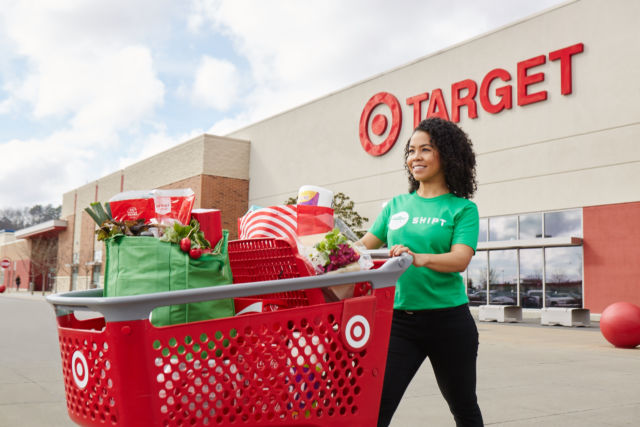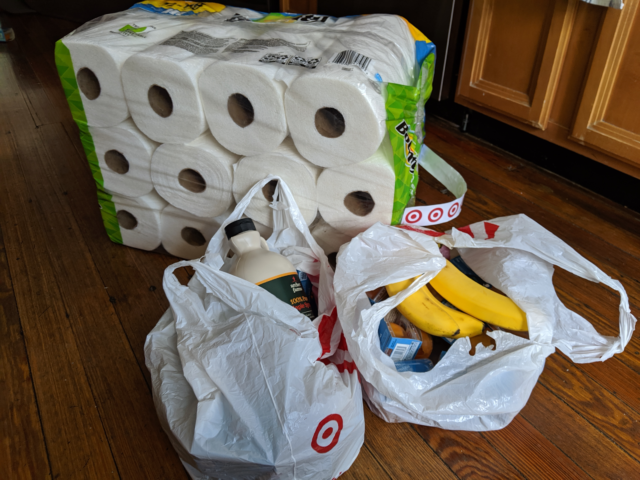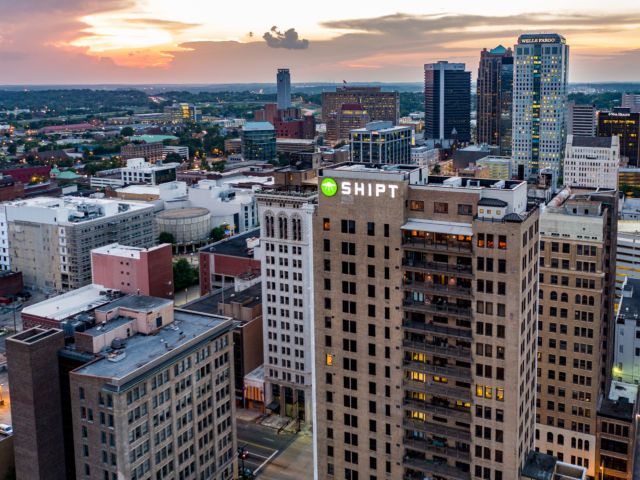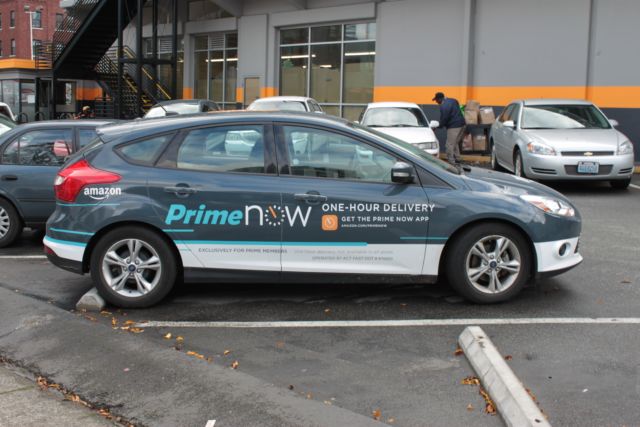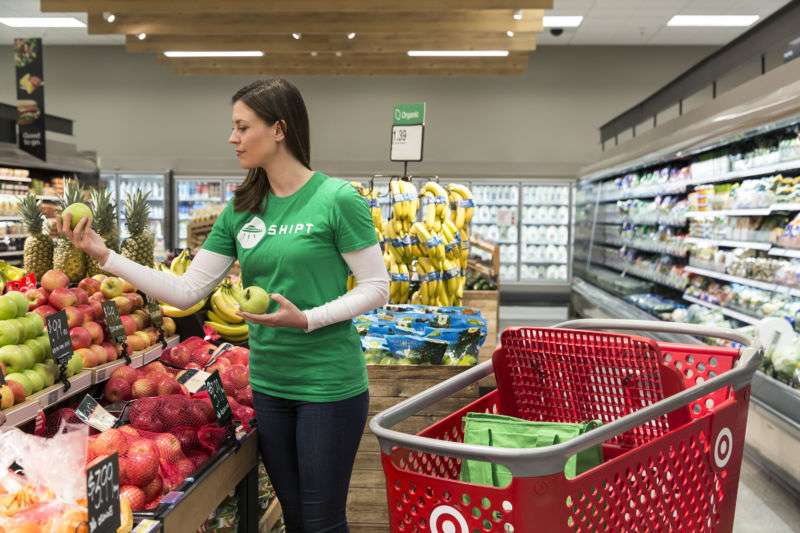
Target’s same-day deliveries might break my Amazon Prime addiction

On Thursday, Target unveiled a new same-day ordering feature on its website. For just $9.99, customers can get items delivered to their door in a couple of hours. I gave the service a try on Thursday, and I loved it. It was fast, convenient, and affordable.
The part I’m most excited about, though, is something that isn’t actually new—though I hadn’t heard about it until yesterday. Target’s same-day delivery option is powered by a startup called Shipt that Target acquired in 2017. And Shipt has a subscription offer that I find compelling: for $99, you can get a year of free same-day deliveries on any Target order over $35.
This is such a good deal that it ought to keep Amazon CEO Jeff Bezos up at night. Amazon Prime has been a key driver of Amazon’s growth over the last decade. By making two-day deliveries free, Prime got millions of subscribers in the habit of checking Amazon first for almost anything they buy online.
But one thing that’s even better than two-day deliveries is two-hour deliveries. And while Target can’t match Amazon’s selection, Target’s same-day service offers a wide enough range of products that customers might start to check Target before Amazon for everyday items.
Amazon has a same-day delivery service of its own, called Prime Now. But right now, Target’s service appears to offer better prices, shorter delivery windows, and a more streamlined experience. It’s a serious threat to Amazon’s e-commerce dominance.
My Target same-day delivery experience
At the time that I saw Target’s announcement Thursday, I was overdue for a grocery run. So I decided to give the service a try. I ordered grapes, blueberries, bananas, a lot of baby food, two types of breakfast cereal, and eggs. Target was offering a $15 gift card for orders over $100, so I added a few non-perishables—maple syrup and two large packages of paper towels—to get me over the $100 threshold.
While Target aims to complete deliveries within two hours, it took a little longer in my case—possibly reflecting a surge of demand after Target’s announcement. Shipt does deliveries in one-hour windows, and when I checked out just after 1pm, the earliest available delivery window was from 4pm to 5pm. That wasn’t actually convenient for me so I selected a window from 6pm to 7pm instead.
At 5:50pm, I got a text message letting me know that my groceries had been bagged and were on the way. A woman showed up at my doorstep a few minutes after 6pm. I got exactly what I ordered, with one exception: I ordered three bananas, but they delivered four. They only charged me for three, though, so I can’t complain.
The quality of the produce was pretty good. The blueberries, bananas, and pineapple were excellent. A few of the grapes were overripe, but the rest weren’t bad.
Target’s website was amazingly—perhaps alarmingly—good at suggesting items to order. I’d never used the same-day shipping service before, but a carousel at the top of the order page showed me a variety of items I had ordered before. A few of these were items I’d previously ordered from Target’s regular two-day delivery service but most of them were items that my wife or I had purchased during in-person Target shopping trips.
I assume Target did this by correlating credit cards I’ve used in the store with those I’ve used on the Target website online. My wife and I share a credit card, so that may be how some of her purchases wound up among my suggested items.
Target offered competitive prices
The total bill was $131.12, a figure that included a $9.99 delivery charge and $1.28 in taxes.
For comparison, I constructed a shopping cart at my local grocery store, which also offers same-day delivery. My total there was $146.71, which included a $16.90 delivery fee. About $3 of this reflected the fact that they only sold 2-pound bags of grapes rather than 1.5-pound bags target offered, but the shopping carts were otherwise identical. The grocery store charged higher prices on baby food, paper towels, and maple syrup.
Target also gave me $20 in gift cards for use on my next purchase—a $15 thank you for using the service for the first time and a $5 reward for purchasing two giant 12-packs of paper towels.
The checkout process on Target’s website was hassle-free. The grocery store’s site was comparatively clunky, and for some reason it wasn’t able to accept payments on its website—customers needed to either use the store’s app or make a phone call to provide credit card information.
What about Amazon? Amazon Prime Now works on a per-store basis, so I had a choice between getting items from my nearest Whole Foods or a different selection of items directly from the Prime Now warehouse. (You can order from both, but that means accepting two different deliveries and paying two $4.95 fees if you want one-hour delivery windows.)
Whole Foods didn’t have a lot of the items I ordered from Target, including name-brand cereal and baby food, so I create a comparison-shopping basket using Prime Now warehouse items. Prime Now had everything on my list except for pineapples.
But a number of items were significantly more expensive, including paper towels, maple syrup, and Frosted Mini Wheats. Prime Now charged slightly less for Wheaties. Overall, shopping with Prime Now would have cost me about $10 more—assuming I had subscriptions to both Prime and Shipt.
Target’s same-day service has Alabama roots
Shipt, the company that developed Target’s same-day delivery technology, was launched from Alabama in 2014. Reading coverage of the company prior to its December 2017 acquisition by Target provides insight into how the service works.
Back in 2016, Techcrunch reported that Shipt “charges $99 for a year of delivery service or $14 per month and there’s about a 15% markup on items where there’s no retail partnership.”
From Shipt’s perspective, these deliveries weren’t cheap. At the time, Techcrunch reported that Shipt was paying shoppers “about $17 per-shop. Typically it’s a base fee of $5 plus 7.5% of the order and whatever tips they get on delivery.” Techcrunch said that was competitive with what other delivery services offered.
Retailers are generally willing to pay a small fraction of their sales to delivery services like Shipt because they bring in extra business while potentially reducing the store’s labor costs.
At the time, Shipt claimed to be “profitable in most of its markets.”
One key to Shipt’s business model, Techcrunch reported in 2017, was that deliveries aren’t quite on-demand. Instead, Shipt “provides customers with several delivery windows from which to choose,” Techcrunch’s Jonathan Shieber wrote. “By setting up those windows for delivery, the company can better manage logistics and improve the efficiency of its entire delivery system.”
The company still seems to be employing this model today—though average shopper pay may be lower than $17 per shop today. When I placed my order, I was asked to choose a one-hour delivery window. The woman who delivered my groceries told me that she lives in my neighborhood and only picks up deliveries nearby.
It’s easy to see how this model could become more efficient as more people use the service. If several people in the same neighborhood order deliveries for the same one-hour window, Shipt can assign all of them to the same driver, who can pick up the items from the local Target, then make stops at each customer’s house before the hour is over.
And Shipt’s approach of charging a flat $99 price for unlimited deliveries encourages customers to use the service more, helping the company to achieve the economies of scale needed to make this model cost-effective.
A serious threat to Amazon?
Delivering groceries for $9.99 would be a pretty valuable service all on its own. But the combination of a low annual subscription price and Target’s broad non-grocery selection make Target’s new service something much bigger: a serious threat to the supremacy of Amazon Prime.
As I was writing this article around 9pm on Thursday evening, I went back to Target’s site to check out the non-grocery options for same-day delivery. It turns out I can order a kid’s bike, some shelves, a 26-pound box of cat litter, a shower curtain, a pressure cooker, or some bath towels. And with an annual subscription, I can get any order over $35 delivered, for free, in about two hours.
Indeed, when I first started mulling these options around 9pm on Thursday, the site was still offering to deliver a kid’s bike to me by 11pm that night. Around 9:15pm, that option disappeared. I would have needed to wait until 10am Friday morning to get a box of cat litter and a shower curtain.
The power of Amazon Prime was the way it has habituated millions of consumers—including me—to making Amazon the default way that we buy almost everything online. As customers bought more and more stuff via Prime, Amazon was able to achieve unrivaled economies of scale. Amazon was able to build larger, more efficient warehouses, negotiate better rates with suppliers and shippers, and further drive down average delivery times. And Amazon Prime includes access to Amazon’s massive streaming library. Competitors have struggled to catch up.
But now Target has a shot at breaking customers’ Amazon addictions.
Obviously, Target’s 65,000-item selection doesn’t come close to matching the millions of items available on Amazon. But it is broad enough that I might start checking Target’s site before checking Amazon when I’m buying items in categories Target carries. After all, getting things in two hours is a lot nicer than getting them in two days.
Amazon is pushing in the same direction with Prime Now, and it’s a pretty good service. But right now Target seems to have the edge, with shorter delivery windows and better prices on some groceries. And it might be hard for Amazon to catch up.
To make Amazon Now work, Amazon has needed to build a nationwide network of warehouses so they can have products ready near every customer. Target, of course, already has its nationwide network of stores, greatly simplifying the process of offering same-day deliveries.
